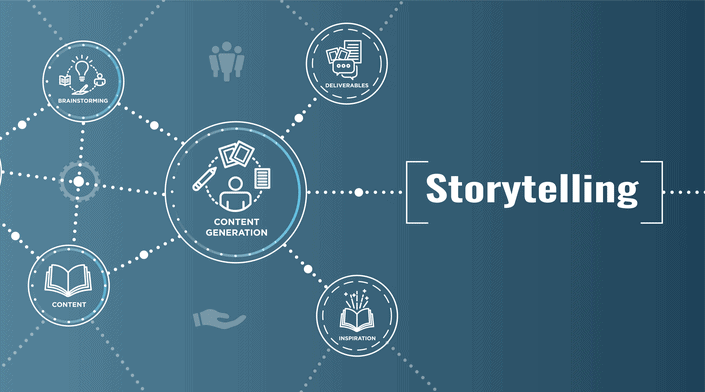The Power of and Importance of Storytelling in Content Marketing
Storytelling has been an essential part of human communication since the dawn of time. With the advent of content marketing, it has taken on a new role and importance. Storytelling in content marketing is more than just weaving tales; it’s about creating a narrative that your audience can connect with on a personal level. It’s the art of using narrative to engage, persuade, and inspire your audience.
Content marketers use storytelling to help their audience understand their brand, products, and values. They use it to build trust, to create an emotional connection, and to engage their audience in a way that traditional marketing techniques often fall short. In essence, storytelling is a powerful tool that can elevate your content marketing strategy to new heights.
Understanding Storytelling: Its Roots and Impact
Storytelling has its roots in ancient cultures, where stories were used to pass down history, traditions, and knowledge. This method of communication was so effective that it has survived thousands of years and is still a primary means of connection and learning.
In the context of content marketing, storytelling has a profound impact. It helps brands to stand out in a saturated market, connect with their audience on a personal level, and create a lasting impression. Storytelling in content marketing is not just about telling a story; it’s about telling your story. It’s about conveying your brand’s personality, values, and mission in a way that resonates with your audience.
The Science Behind Storytelling: Why It Works
Storytelling is not just an art; it’s a science. Research in neuroscience has shown that stories stimulate the brain in ways that other forms of communication do not. When we listen to a story, our brains release oxytocin, a hormone that is associated with empathy and trust. This is why stories have the power to move us, to make us feel connected, and to influence our decisions.
In content marketing, storytelling can be a powerful tool to engage your audience, build trust, and drive action. By weaving your marketing messages into a narrative, you can tap into the psychological power of stories and create a deeper, more meaningful connection with your audience.
Incorporating Storytelling into Your Content Marketing Strategy
Incorporating this strategy into your content marketing strategy is not just about telling stories. It’s about crafting narratives that align with your brand, resonate with your audience, and support your marketing goals. It’s about using stories to convey your brand’s personality, to illustrate the benefits of your products, and to inspire your audience to take action.
To effectively incorporate storytelling into your content marketing, you need to understand your audience, their needs, their aspirations, and their challenges. You need to create stories that speak to these factors, that provide value, and that compel your audience to engage with your brand.
There are many examples of businesses that have successfully used storytelling in their content marketing. These businesses have been able to create a strong connection with their audience, build brand loyalty, and drive significant results.
One example is the outdoor clothing brand, Patagonia. They use to tell a story to highlight their commitment to environmental sustainability, to connect with their eco-conscious audience, and to differentiate themselves in a competitive market. Through their stories, they are able to convey their brand values, inspire their audience, and drive action.

Tools and Techniques for Effectiveness
There are many tools and techniques that you can use to craft compelling stories in content marketing. These include using strong visuals, incorporating customer testimonials, and leveraging data to create compelling narratives.
Visual storytelling, for example, is a powerful way to engage your audience. Images,videos, and infographics can bring your stories to life, make them more engaging, and help your audience understand your message.
Customer testimonials are another effective storytelling technique. By sharing the stories of your customers, you can provide social proof, build trust, and show your audience the real-life impact of your products or services.
Common Pitfalls and How to Avoid Them in Telling a Story
While storytelling can be a powerful tool in content marketing, it’s not without its pitfalls. One common mistake is focusing too much on the brand and not enough on the audience. Remember, your audience is the hero of your story, not your brand. Your role is to guide them, to help them overcome their challenges, and to provide them with a solution.
Another common mistake is telling stories that lack authenticity. Your audience can tell when a story is not genuine, and this can damage your brand’s credibility. To avoid this, make sure your stories are true, relatable, and align with your brand’s values.
Conclusion: Leveraging Storytelling for Content Marketing Success
In conclusion, storytelling is a powerful tool that can elevate your content marketing strategy. It can help you connect with your audience on a deeper level, build trust, and drive action. By understanding the art and science of storytelling, and by avoiding common pitfalls, you can leverage storytelling for content marketing success.
Remember, storytelling in content marketing is not just about telling stories. It’s about telling your story. It’s about conveying your brand’s personality, values, and mission in a way that resonates with your audience. So, go forth and tell your story. Your audience is waiting.









